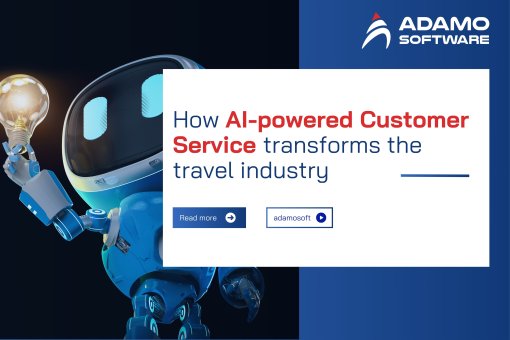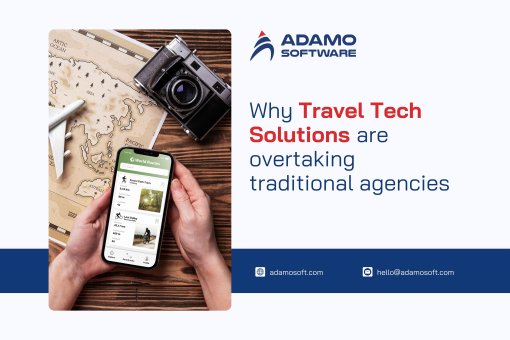AI in tourism: Benefits, challenges and top applications
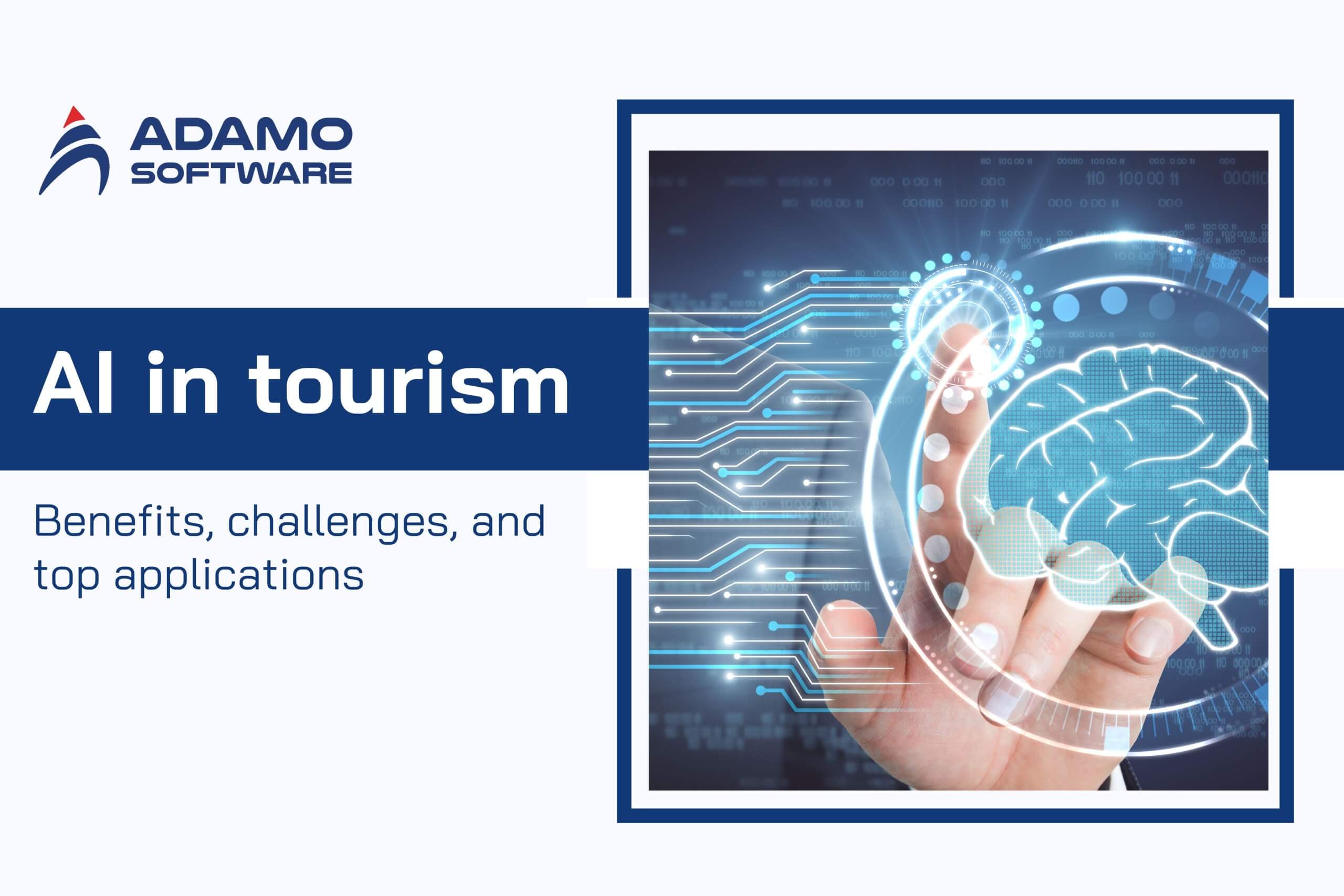
Currently, AI is getting more popular in the travel industry. Let’s learn about the adoption of AI in tourism!
AI has been adopted in almost every aspect of human life. One of the outstanding industries that is using AI for improving performance is the tourism industry. AI in tourism is the way AI is applied in enhancing travel services, travel planning, pricing, marketing, etc. With capabilities in large-scale data analysis, process automation, and cognitive assistance, AI drives personalized service and optimized outcomes. Let’s learn about the adoption of AI in tourism with Adamo Software!
Through this blog post, you will find out the following pieces of information.
- The role of AI in transforming tourism industry
- Benefits of embracing AI in tourism
- Risks and ethical consideration of AI in tourism
- Top uses of AI in travel and tourism industry
All of the information has been thoroughly researched and updated to the latest trends. So, let’s read our blog post and find some useful information. Now, it’s time to delve into each aspect.
I. The role of AI in transforming tourism industry
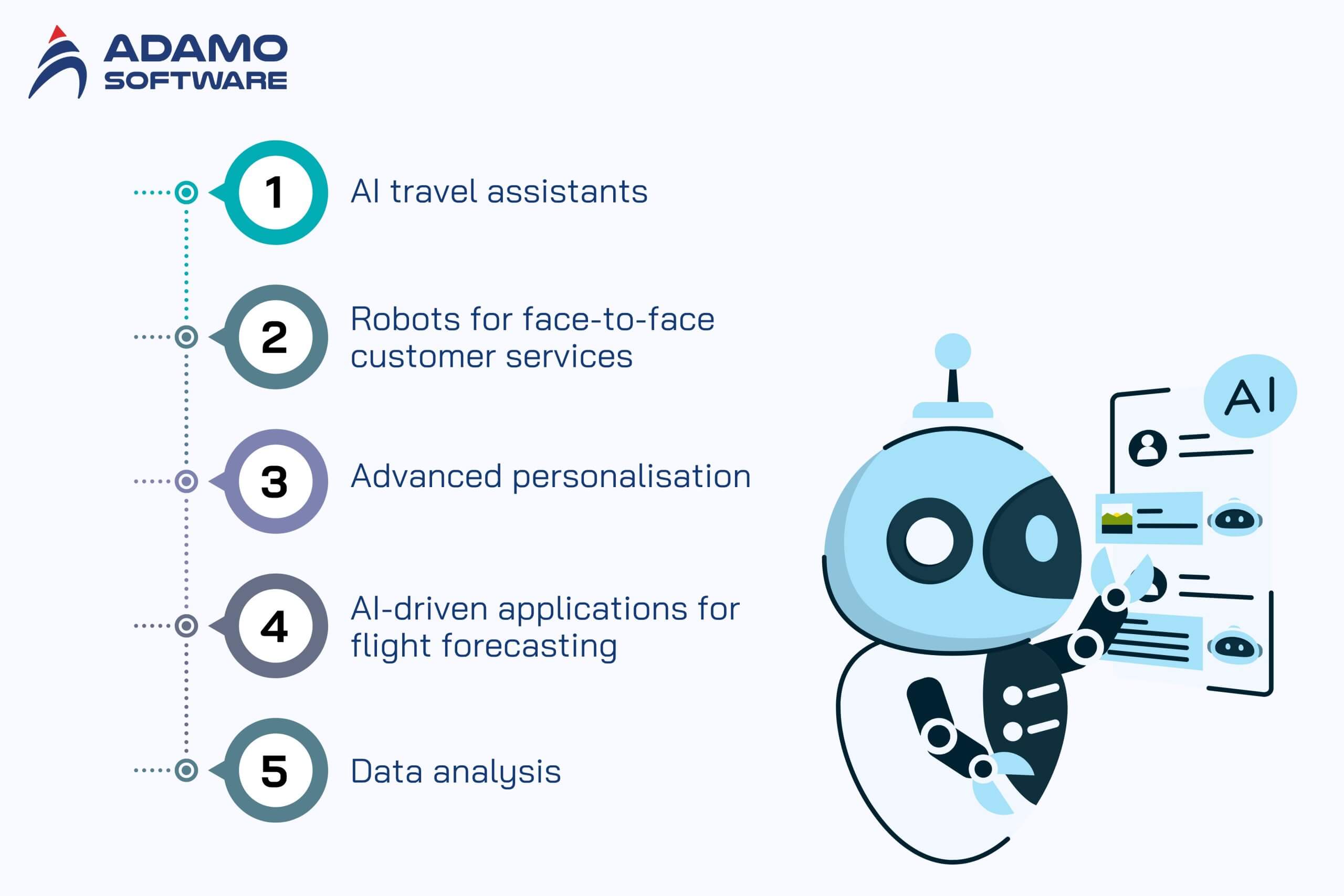
AI plays an important role in transforming the tourism industry, bringing various innovations. They include AI travel assistants, robots for face-to-face customer services, advanced personalization, AI-driven applications for flight forecasting, and data analysis. Here’s a quick look at each innovation.
- AI travel assistants – Planning support for your journey
- Robots for face-to-face customer services – AI chatbots helps improve customer services
- Advanced personalization – Personalized travel suggestions
- AI-driven applications for flight forecasting – Flight demand forecasting
- Data analysis – Analyzing and predicting data
Let’s delve into each innovation, thereby concluding the role of AI in tourism changes!
1. AI travel assistants
The role of AI in tourism is partly reflected through the AI travel assistants, which serve as a virtual tour guide that supports tourists’ journeys. AI streamlines everything, from searching for flights, booking accommodations, to suggesting sightseeing itineraries. Thanks to this, tourists can save time when preparing for their trip.
Besides helping tourists prepare for their trip, AI travel assistants also accompany tourists throughout their journey. When there are unexpected changes such as flight delays or schedule changes, the AI assistant can update information and suggest alternatives immediately.
Another important role of AI in tourism that AI travel assistants help is their ability to integrate with users’ personal tools. For example, AI can automatically add itineraries to calendar apps, remind important milestones, or suggest additional services. This makes tourists’ journeys more complete and convenient.
2. Robots for face-to-face customer services
Robots for face-to-face customer services have become an outstanding trend of AI in tourism, especially at hotels and airports. They can assist with check-ins, guide tourists to their rooms, and answer frequently asked questions in multiple languages. This reduces the workload on human staff and increases efficiency in service.
Besides, robots also serve as chatbots that support 24/7 online communication, helping customers receive instant feedback via websites or application. They are convenient in handling frequently asked questions such as booking services, baggage policies, or flight status. With the ability to respond quickly and accurately, robots contribute to improving customer satisfaction throughout the journey. Generally, through the application of robots and chatbots in direct customer service, AI is transforming the tourism industry. Thanks to AI, businesses can reduce the workload for employees, improve operational efficiency and bring a more satisfying experience to customers.
3. Advanced personalization
Advanced personalization is also another innovation of AI in tourism that is changing the industry. This allows businesses to provide experiences following tourists’ preferences. By analyzing data from search behavior, service booking history or personal preferences, the AI system can suggest flights, hotels and sightseeing activities based on actual needs.
Besides, this innovation also helps create instant recommendations during the experience. For example, if a guest frequently searches for local restaurants, AI can suggest suitable eateries near their current location. This personalization makes it easy for guests to access the right service without spending a lot of time searching.
Overall, AI is transforming the tourism industry through enhanced personalization, helping businesses deliver experiences tailored to each traveler. As a result, tourists can easily access the right service, while businesses improve customer satisfaction and engagement.
4. AI-driven applications for flight forecasting
Applying AI in tourism means that businesses can forecast flights using AI and data science. By analyzing statistical patterns and trends from multiple segments of the travel industry, AI systems can accurately predict flight demand, helping airlines proactively plan and allocate resources more effectively.
Thanks to the ability to forecast, businesses can improve customers’ overall travel experience. Customers can choose the right time to book tickets at the optimal price or avoid the risk of missing flights.
Beyond forecasting, this innovation also helps airlines optimize revenue and manage operations. By keeping tracks of the travel trends, airlines can adjust pricing policies, plan flight schedules, and increase competitiveness. This is how AI in tourism is shaping the future of the aviation industry.
5. Data analysis
Data analysis is also one of the innovations of the application of AI in tourism, which allows businesses to leverage massive amounts of data from customer behavior, service bookings, and market trends. Implementing data automation allows firms to construct descriptive, predictive, and prescriptive models, which serve as foundational pillars for effective decision support.
Besides, data analysis also helps to detect new trends in the tourism industry early. Businesses can quickly adjust their products, marketing campaigns, and operating processes to keep up with the market. This shows how AI in tourism is changing the way companies make decisions and improving the overall experience for travelers.
You can explore more about how AI in Travel Industry is changing travelers experience here.
II. Benefits of embracing AI in tourism
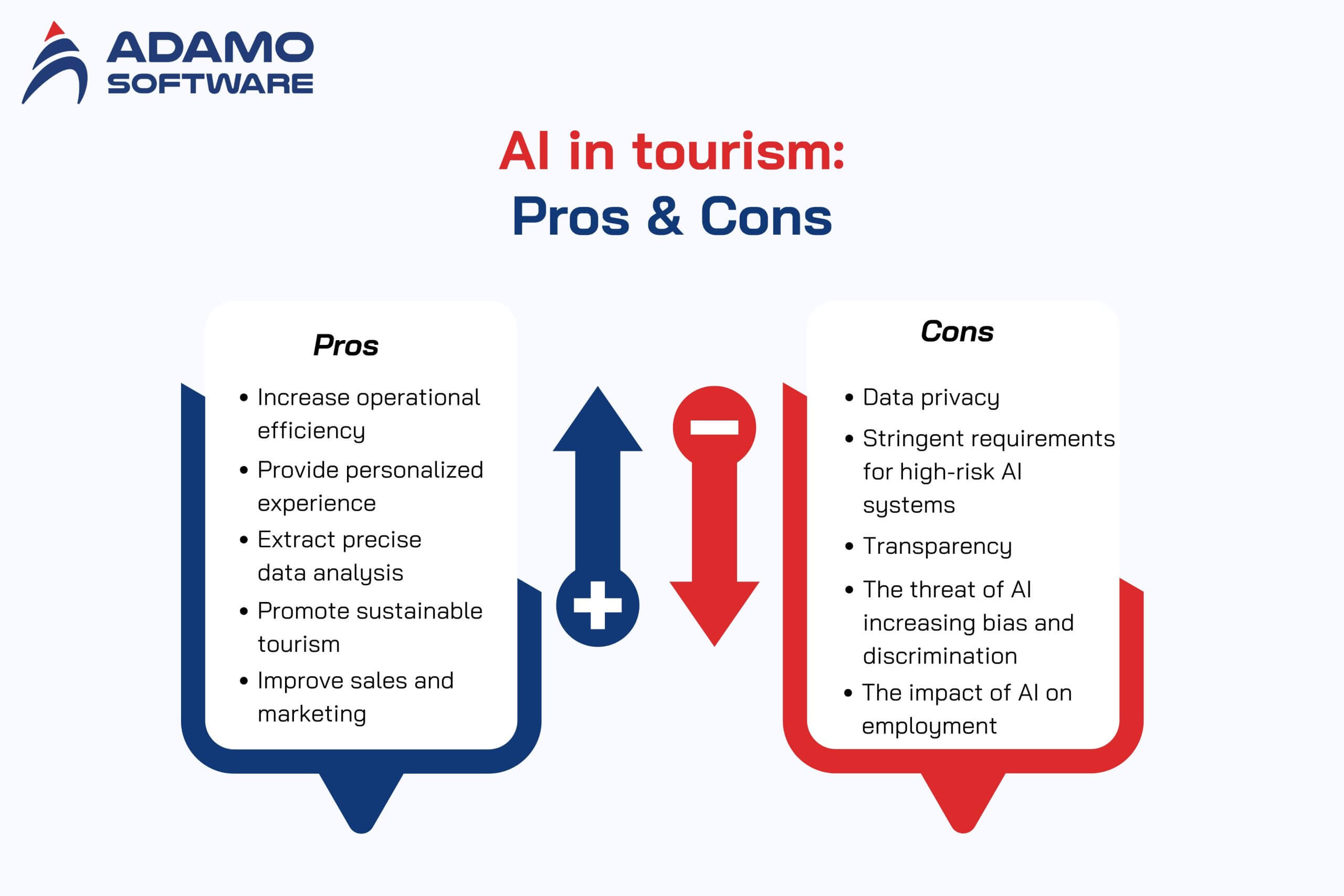
From automated process management to error minimization, AI is transforming travel operations. This technology is key to generating predictive insights on traveler behavior, delivering customized solutions, strengthening customer engagement, and optimizing service management throughout the trip. Below are some notable benefits of embracing AI in tourism.
- Increasing operational efficiency – Optimal, automatic, efficient, accurate, and fast
- Providing personalized experience – Creating customized itineraries
- Extracting precise data analysis – Providing valuable insights
- Promoting sustainable tourism – Preserving natural habitats and cultural heritage
- Improving sales and marketing – Targeting the right customers and optimizing profits
Let’s delve into each benefit with Adamo Software!
1. Increasing operational efficiency
Applying AI in tourism helps travel companies increase operational efficiency. Predictive analytics streamlines the allocation of resources and precisely optimizes inventory levels, driving efficiency. By reducing manual workload, process automation empowers staff to concentrate on high-value, complex, and strategic tasks instead of routine operations. Thus, businesses can boost productivity and significantly minimize errors.
2. Providing personalized experience
Providing personalized experiences is also another outstanding advantage of adopting AI in tourism. AI leverages traveler history, demographics, and contextual cues to match individuals with highly personalized options for where to go, where to stay, what to do, and where to eat, to craft unique trips to customers.
By analyzing user intent and declared preferences, businesses can precisely tailor itineraries and personalized offers that suit the specific needs of every traveler. Personalized experiences foster a deeper emotional connection with customers, which drives higher customer loyalty, recurring transactions, and positive testimonials.
3. Extracting precise data analysis
Through the use of AI in tourism, businesses can have precise data analysis. It allows travel companies to process and analyze large, intricate data sets. Machine learning algorithms process historical data to surface crucial trends, patterns, and correlations, thereby providing companies with actionable insights into both customer behavior and market dynamics.
Thanks to this, businesses can quickly implement new marketing strategies, launch product development initiatives, and execute operational improvements, ensuring a dynamic response to the surrounding environment. Reliable data analysis empowers organizations to forecast market shifts, minimize potential risks, and aggressively pursue emerging opportunities.
4. Promoting sustainable tourism
Adopting AI in tourism also contributes to promoting sustainable tourism. Predictive analytics algorithms drive maximum efficiency by optimizing transport routing, which directly translates to lower fuel consumption and a reduction in the carbon footprint.
AI-based monitoring systems track energy, water, and waste metrics to instantly identify opportunities for improving efficiency and driving resource conservation. AI aids in preserving natural habitats and cultural heritage by promoting responsible tourism practices and actively supporting environmental conservation initiatives.
5. Improving sales and marketing
By adopting AI in tourism, travel companies can improve their sales and marketing. It allows businesses to precisely target ideal customers and significantly boost their conversion metrics.
For instance, recommendation engines deliver personalized content and offers, directly boosting user engagement and conversion rates. Predictive analytics algorithms precisely identify high-value customer segments, allowing marketing campaigns to be customized and deployed for maximum impact. By strategically optimizing the placement, timing, and messaging of advertisements, automated marketing platforms ensure the highest possible ROI and significantly boost profitability.
III. Risks and ethical consideration of AI in tourism
While the integration of AI in tourism brings many benefits to the industry,
companies must address various challenges and ethical considerations to ensure its responsible and balanced application. Below are some risks and ethical considerations of AI in tourism.
- Data privacy – AI and data security
- Stringent requirements for high-risk AI systems – Comply with strict EU AI regulations
- Transparency – AI transparency and accountability
- The threat of AI increasing bias and discrimination – Regular audits and updates to AI models needed
- The impact of AI on employment – New job opportunities and displacement simultaneously
Let’s discuss each risk in detail with Adamo Software!
1. Data privacy
Data privacy is one of the main concerns of adopting AI in tourism. Since AI systems require vast amounts of personal data to function, businesses must carefully manage how this data is collected, stored, and used. Companies must strictly comply with regulations such as the GDPR to protect user privacy, which is essential for building customer trust.
Additionally, data security of AI in tourism is also associated with customer experience. Travelers often provide a lot of personal information when booking tickets, reserving rooms, or participating in online services, which may lead to data leakage. To build lasting trust, businesses need to apply advanced encryption technologies, establish transparent privacy policies, and regularly update security systems to ensure that customer information is always kept safe.
2. Stringent requirements for high-risk AI systems
The European Union’s AI Act mitigates AI risks by setting stringent requirements for high-risk AI systems, which require rigorous testing and certification prior to deployment. This means that AI systems in tourism with high risk, such as facial recognition technology at airports or systems analyzing tourist behavior, must undergo strict inspection before being put into use. This process helps ensure that AI operates transparently, safely, and does not negatively impact customers’ privacy or fairness. As a result, the tourism industry can harness the benefits of AI while maintaining trust from travelers and regulatory authorities.
3. Transparency
Transparency is also another factor that businesses must consider when applying AI in tourism. This requires that users be informed when they interact with AI and that the limitations of these systems are clearly communicated. This ensures users are fully aware of the AI’s presence and capabilities, promoting accountability. Transparency is especially important in AI in tourism, as it enables customers to make more reliable decisions.
4. The potential for AI to increase bias and discrimination
The potential for AI to increase bias and discrimination is also one of the notable ethical considerations of adopting AI in tourism. When AI systems are trained on biased data, they can unintentionally continue those biases, resulting in the unfair treatment of people based on race, gender, or other characteristics. Fair and unbiased AI requires ongoing vigilance, achieved through regular model audits and updates.
5. The impact of AI on employment
The impact of AI on employment is among the privacy considerations when businesses start to use AI in tourism technology. AI improves efficiency and creates new jobs, but it also carries the risk of job displacement in some sectors. To mitigate these effects, businesses must balance technological advancement with robust workforce development and retraining programs. The implementation of AI in tourism needs to be accompanied by policies that support workers in career transitions, in order to ensure sustainable development for the entire industry.
IV. Top uses of AI in travel and tourism industry
AI is transforming how the travel and tourism industry works by providing a huge number of new capabilities. Below are some use cases of AI in tourism.
- Hotel search and booking – Personalized hotel booking
- Itinerary planning and recommendations – Itinerary suggestions and scheduling
- Predictive analytics for demand forecasting – Tourism demand forecast
- Facial recognition – Recognizing tourists’ face
- Chatbots for customer support – Answering tourists’ questions 24/7
Let’s see how each case is applied in reality with Adamo Software!
1. Hotel search and booking
Hotel search and booking is one of the popular use cases of AI in tourism. AI systems can process a large amount of data, from room rates, locations, amenities, to customer review. Thanks to this, customers can quickly find and access suitable accommodations without manual search, which takes a lot of time.
This use case of AI in tourism helps businesses tailor the experience. AI analyzes behavior, booking history, and customer preferences to provide hotel suggestions that closely match actual desires. For example, business travelers will receive recommendations for hotels near convention centers, while vacationers will be suggested beachfront resorts. This helps enhance satisfaction and increases the likelihood of returning to use the service.
2. Itinerary planning and recommendations
Besides accommodation, adopting AI in tourism also helps businesses tailor their customers’ itinerary. Instead of searching for information from multiple sources, customers can receive an optimized travel itinerary in just a few seconds. AI aggregates data from destinations, modes of transportation, duration of stay, and costs to create the most suitable plan for each individual.
This use case of AI in tourism is outstanding with the ability to personalize. AI provides suggestions tailored to each traveler based on their preferences, travel habits, and budget. For example, if a person wants to learn about culture and history, AI will recommend museums and historical sites. Meanwhile, adventure seekers will have itineraries featuring outdoor activities.
3. Predictive analytics for demand forecasting
Predictive analytics for demand forecasting is an important use case of AI in tourism. This helps tourism businesses make strategic decisions. AI has the ability to process large amounts of data from various sources such as search trends, booking history, local events, and market fluctuations. This allows businesses to accurately predict when travel demand will rise or fall and make appropriate preparations.
Through this use case of AI in tourism, businesses can optimize their resources. For example, hotels can use AI to identify peak periods and allocate additional staff, goods, or necessary services. Airlines can also adjust flight schedules, ticket prices, and operational plans based on demand forecasts.
4. Facial recognition
Facial recognition technology is getting more popular in the adoption of AI in tourism. This technology helps to enhance the experience and strengthen security for travelers. At airports, hotels, or amusement parks, facial recognition systems help automate the check-in process, minimize waiting time, and provide maximum convenience.
This use case of AI in tourism also helps enhance security. The system can detect unusual behaviors or identify individuals on watchlists, contributing to the safety of both customers and businesses.
5. Chatbots for customer support
Chatbots for customer support are a useful case of adopting AI in tourism. Thanks to the ability to operate 24/7, chatbots can quickly answer questions, assist with booking, or provide information about destinations for travelers at any time. This helps save on staffing costs and improves customer satisfaction.
A notable advantage of chatbots for customer support is their ability to handle multiple languages and personalize the experience. Visitors from different countries can communicate in their own language, while the chatbot uses search history and behavior to provide appropriate suggestions.
Additionally, AI in tourism with chatbots also helps businesses collect and analyze customer data. Questions, feedback, or behaviors of tourists when interacting with chatbots help businesses improve services and develop new products.
V. Final thoughts

In conclusion, AI has transformed the tourism industry through many benefits that it brings to travel companies, from optimizing operations to enhancing customer satisfaction. The application of AI in tourism brings many benefits such as personalized services, improved management efficiency, improved sales and marketing, etc. However, it also comes with risks and ethical challenges.
If you want to integrate AI development services in tourism and overcome the challenges, you may need support from a reliable partner. As one of Vietnam’s leading travel and hospitality software development companies, Adamo Software can be your choice. Here’s how we can help.
- Consulting the adoption of AI in tourism strategy
- Developing customized AI solutions
- Integrating AI into existing systems
- Ensuring security and regulatory compliance
- Training and post-project operational support
Still hesitating whether to choose Adamo Software? Let’s contact us for more detailed information!
FAQs
1. How is AI used in travel?
Businesses use AI in tourism for planning and customizing tourists’ itinerary, predicting demand, adjusting prices, and optimizing operations. Besides, AI also helps handle customer queries 24/7, streamline booking processes, and enhance customer service.
2. What is the future of AI in tourism?
In the future, AI will be getting more popular in the tourism industry. AI in tourism will be associated with smart experiences such as virtual guides, instant translation, and real-time suggestions, etc.
3. What is the role of AI in travel and tourism?
In the travel industry, AI is applied to improve efficiency and productivity of operations, augment accessibility, and drive innovation. This allows businesses to elevate their service like never before.
4. Is AI in tourism expensive?
The cost of implementing AI for a travel company varies based on complexity, required features, and project duration. According to Business Plan, the initial investment for an AI travel platform typically ranges from $250,000 to $500,000, depending on complexity. This cost covers the design, integration of machine learning algorithms, and development of a seamless user experience.







